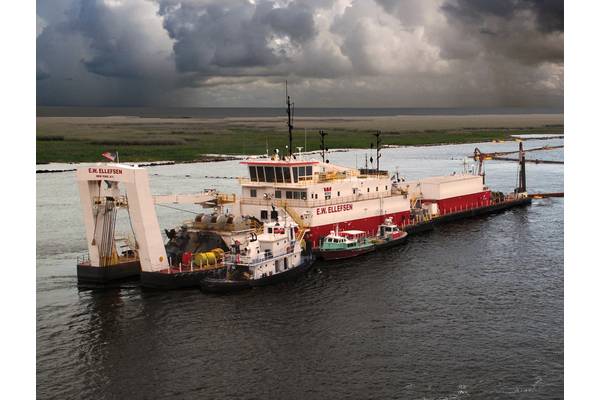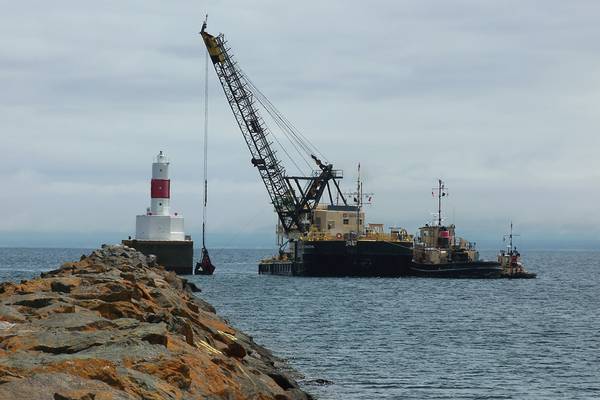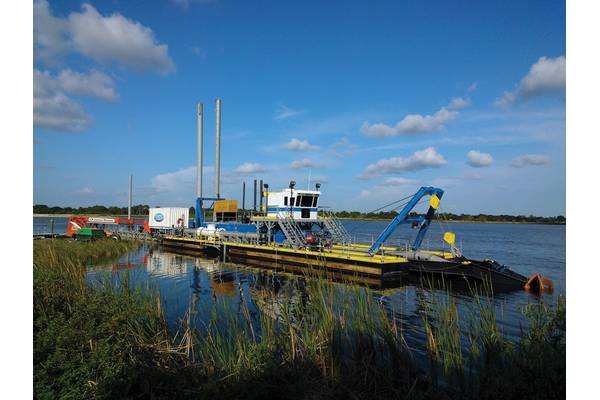


Passage of WRDA would increase dredging dollars and alter the nation’s intermodal equation. Maritime stakeholders hold their breath.
Deferred dredging and maintenance for domestic ports, harbors and critical waterways means that vessels must carry less cargo. It’s that simple. Sometimes, they can’t move at all. When channels aren’t dredged to intended dimensions, all stakeholders – manufacturers, agricultural interests and vessel operators alike – lose money. And the risk of ships grounding or colliding grows.
It is no secret that the maritime industry wants to see funds collected by the federal Harbor Maintenance Tax (HMT) are fully used for maintenance dredging. The tax, implemented in 1986, is levied at $1.25 per $1,000 of cargo value on importers and domestic shippers using coastal or Great Lakes ports. Exporters don’t have to pay the tax following a Supreme Court decision in 1998. Revenue is held in the Harbor Maintenance Trust Fund or HMTF. Congress appropriates money from that fund for dredging.
Last month, the U.S. Senate passed the Water Resources and Development Act, a bill that would increase spending on dredging using HMTF money. Sponsored by Republican David Vitter of Louisiana and Democrat Barbara Boxer of California, WRDA was approved on May 15 in a Senate vote of 83 to 14. Now, hopes are that the House will pass the bill.
WRDA: Dredging our Way Back
Jim Walker, Director of Navigation Policy and Legislation with the American Association of Port Authorities in Virginia, last month said “Most major U.S. ports, particularly those on the Atlantic and Gulf coasts have an annual, maintenance dredging requirement. The greatest challenge is the Mississippi River from Baton Rouge to the Gulf, where flooding and drought result in large variations in annual dredging requirements.” He adds, “This year’s flooding will make it a big dredging year on the lower Mississippi.”
The U.S. Army Corps of Engineers is responsible for the nation’s navigation systems. Ports rely on fed-funded maintenance dredging. But, port development and maintenance involves federal, state and local governments, along with the private sector. The federal government maintains harbor access channels, while ports build and service landside facilities and contribute to channel improvement through cost-sharing. Walker insists, “We need to have full use of the revenue collected each year from the HMTF. The federal dredging budget allocates $850 million to $900 million annually for navigation channel maintenance dredging but $1.6 billion is being collected by the HMTF yearly.” WRDA, he says, will incrementally increase allocations to dredging and harbor maintenance, with full use of HMTF money taking place in 2020.”
Walker continued, “We’re pleased to see the WRDA bill, especially since it’s been six years since the last one. But we won’t get to where we need to be overnight with WRDA. Increased funding under WRDA is good but proper maintenance of navigation channels requires full use of HMTF revenues.” After the Senate passed WRDA last month, the House of Representatives will take up the bill.
Big River Coalition: Aggressively Pushing the Agenda
Sean Duffy, Executive Director of the New Orleans-based Big River Coalition, maintains that government spending on dredging should be double the current levels. “The easiest solution would be to allocate the full revenue from the HMTF,” he said “Revenue from this ad valorem-based tax continues to increase and is approaching $2 billion per year. In fiscal 2012, a little over half, or $844 million, of the yearly HMTF revenue of nearly $1.7 billion was allocated for harbor maintenance.” In essence, more than half of the FY 2012 HMTF revenue wasn’t used for its intended purposes. That’s not unusual, say industry stakeholders.
The Office of Management and Budget (OMB) nevertheless – much to the chagrin of waterway users – defends using money in the HMTF for purposes other than waterways. But Duffy told MarineNews in May, “According to the Army Corps, if we use all the HMTF funds raised yearly on dredging, they could maintain all deep-draft channels and harbor maintenance projects. If we spend only $1.5 billion a year, we can start playing catch-up every year. The Corps estimates that if spending were increased to $2 billion a year, all commercial deep-draft ports could be dredged to their full dimensions in five years, and dredging costs would come down eventually.” Also according to Duffy, the Lower Mississippi River is the top-priority project that needs dredging, followed closely by Great Lakes ports.
Addressing Great Lakes’ Sediment
James Weakley, President of Ohio-based Lake Carriers’ Association (LCA), said last month, “the Great Lakes Navigation System needs more than $200 million to restore ports and waterways dimensions. We have a dredging backlog of 18 million cubic yards of sediment. If WRDA doesn’t pass and we don’t get additional HMTF money for the Great Lakes, more harbors will close. If WRDA passes, we’ll start whittling away at the dredging backlog and hope that in 5 to 10 years it will be back to authorized dimensions.” Unchecked, that backlog will grow to 21 million cubic yards of sediment by 2017.
Weakley said “we’re being forced to run inefficiently because the federal government isn’t maintaining the waterways. We’re light loading about 15 percent of our vessel capacity on each trip. We’ve had below-average water for fourteen consecutive years. We’re handicapped by inadequate dredging and lack of water.” He said waterways need to be maintained to support manufacturing and agriculture.
Equipment Usage: Subject to Seasonal Bottlenecks
When asked about the availability of equipment, AAPA’s Walker said “the nation’s dredging market is sized to the federal dredging program. In 2009-2010, with hurricanes and economic recovery funding, the Army Corps successfully managed a dredging program that was twice the size of the current one. Demand for dredging is seasonal, putting a strain on equipment. “The south Atlantic Coast, for instance, can only be dredged four months a year,” he noted. Concerns about wildlife and fish, including migrating birds and winter flounder, dictate when work can be done, and, he added, “Equipment may not always be as immediately available as shippers would like.”
Sean Duffy has a slightly different take on the matter. “Funding is more of an issue than equipment. Funding drives the equipment. If there were a five-year plan to double federal spending on dredging, I’m sure contractors would do everything possible to bring new equipment on line. If the revenue coming in is doubled, you adjust your business plan.”
A new, large hopper dredge costs between $125 million and $150 million, Duffy said. “That’s a huge investment for anyone. You want to know you’ll make a profit, and you’d like the equipment to be working year-round.” Duffy adds, “I think we’re on the borderline of not having enough equipment. But sometimes equipment is sitting at the dock when the owner would like it to be out on a project.” Up north in the Great Lakes, it’s a different story. Jim Weakley laments, “The Great Lakes doesn’t have a shortage of dredging equipment. We continue to have more than enough capacity to get the job done. It’s a matter of having the funds to do the job.”
Domestic Dredging Dig Diligently
U.S. companies catering to the dredge market provide an array of equipment and services and need to be flexible. At Custom Dredge Works, Inc. in Topeka, Kansas, “it’s not uncommon for us to be building two or three dredges simultaneously,” said Chris Gossage, International Sales Manager. “Depending on the customer’s needs, we can build a new custom dredge in five months. A majority of our sales stem from custom equipment orders. We design our dredges to meet a customer’s requirements and do business wherever we’re needed.”
Gossage said “Because of continued steady sales, we’ve grown and we just expanded our facility to 100,000 square feet. We aim to keep lead time down by keeping wear parts fully stocked. Based on our supply system and our predictions of customer needs, we stock accordingly and we supply products across the globe.”
The company’s dredging projects are diverse. “Some of them are large government contracts, and others are for local sand and gravel companies,” he said. “We have a few dozen dredges overseas. We have pretty good representation in Canada and South America.” Gossage adds with confidence, “Because of our strategic project scheduling, lean process and quality systems, we’re poised for substantial growth in the future.”
Post-Panamax Pressure
U.S. Gulf and Atlantic seaports plan to dig harbors deeper to serve post-Panamax ships following the Panama Canal’s expansion and widening, which should be finished in 2015. Last month, the Army Corps awarded a $122 million contract to Great Lakes Dredge & Dock Corp. in Illinois to deepen PortMiami in Florida. Miami’s shipping channels will go from 44 feet deep to between 50 and 52 feet, and part of a channel will be widened so mega-ships can load and discharge cargo. GLDD has dredged Baltimore and other U.S. ports.
By 2030, post-Panamax vessels should account for 62 percent of the world’s container fleet, according to an Army Corps report on ports and waterways, submitted to Congress a year ago. In its report, the Corps said that expansion of Gulf and Southeast ports appears to be justified but the viability of specific projects will depend on current port capacities, trade forecasts and population growth. Access the report on modernizing ports and inland waterways at: http://www.iwr.usace.army.mil/portandwaterways.
Outlook: More Money, Maybe
Sean Duffy sees considerable interest within Congress this year to increase allocations from what he described as “the broken, Harbor Maintenance Trust Fund mechanism.” The HMTF will collect more than $1.7 billion in FY 2014, running from Oct. 2013 to Sept. 2014. WRDA would increase authorized spending for harbor maintenance projects to $1 billion in FY 2014 versus a recent $850 million to $900 million, and would raise authorizations by $100 million every year until a $1.5 billion total is reached.
Separately, AAPA itself has a number of recommendations. AAPA’s U.S. Legislative Policy Council would like to see, among other things, a process to study and construct deep-draft projects; and an updated cost-sharing formula for dredging channels.
One of the issues surrounding HMTF is revenue distribution among ports. HMT money is generally transferred from ports with naturally deep channels to those requiring frequent dredging to maintain channel depths and widths. Louisiana receives a large share of HMTF spending. Mobile, Ala. and Portland, Ore. are fairly expensive to maintain. Meanwhile, Los Angeles, Long Beach, Seattle and Tacoma, and to a lesser extent New York, Boston and Houston are net generators of HMT revenue. These and other issues remain unanswered. Together, stakeholders – both brown water and deep draft players – need to work together towards a common goal. That’s because the one thing everyone can agree upon is that the elusive prize represented by a fully integrated intermodal system hangs in the balance.
(As published in the June 2013 edition of Marine News - www.marinelink.com)



